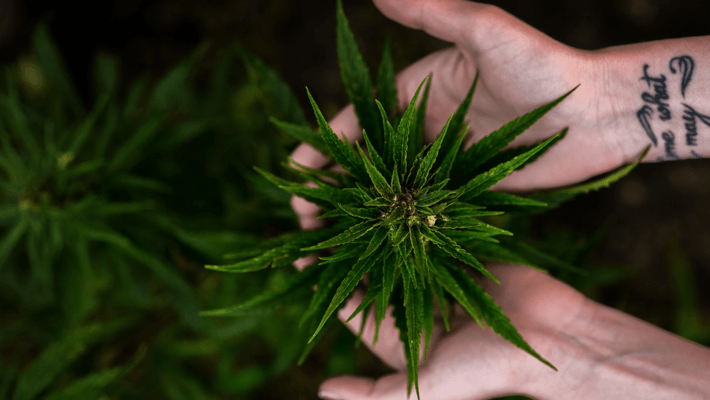
What is the Pinene Terpene in Cannabis?
Published on 8/14/21
Terpenes are organic hydrocarbons that present as oils secreted in the tiny and sticky crystalized glands called trichomes in marijuana buds that are also responsible for carrying most of the plant's cannabinoids. The terpenes provide the strong, distinctive and alluring smells and flavors that are so familiar in cannabis. One of the most prevalent and prominent terpenes in marijuana (and nature) is pinene.
What are Terpenes in the Natural World?
Terpenes are found not just in cannabis, but also in almost every plant across the planet that secretes aromatic oils. They exist for a variety of reasons, but their two main tasks are to use their potent odors to repel predators while at the same time lure insects that are necessary for pollination. Botanists have thus far identified over 50,000 different terpenes in plants on Earth. Scientists have also isolated around 150 terpenes in cannabis where they can interact with cannabinoids like THC and CBD to create different positive effects throughout the body.
Where to Find Pinene
There are two isomers of pinene: alpha-Pinene (or a-Pinene) and beta-Pinene. A-Pinene is by far the most abundant in both nature and cannabis. For that reason, when we are exposed to or notice pinene, it is almost certain to be a-Pinene. It should come as no surprise that the fragrant pine terpene is found in nature in pine trees and smells like pine needles or pine sap. It is also common in rosemary bushes, sage, dill, basil, parsley and lime and orange peels. Eucalyptus oil, juniper blackberries and tea tree oil also contain pinene.
Apart from in nature, the two isomers of pinene are the key component of turpentine, which was used for thousands of years as a cure-all for seemingly every type of ailment. The terpene is also used to flavor products and is put in perfumes, cleaning agents and insecticides.
What Does Pinene Do?
- One of the primary alpha-pinene benefits is its effectiveness as a bronchodilator. That means it widens the bronchi and helps keep the lungs clear; the pinene effects are critical to relief for asthma sufferers.
- Pinene is also a proven anti-inflammatory and "is a potential candidate as a new drug to treat various inflammatory diseases."
- The pungent terpene can also serve as an antimicrobial. This study documents how it can combat the dangerous yeast Candida Albicans, a common cause of fungal infection in the gastrointestinal tract of humans.
- Studies reveal that pinene produces an anti-depressive reaction in mice when combined with the terpene, linalool.
- There is mounting evidence that a-pinene might also be effective against Alzheimer's disease, amnesia, cognitive disorders, general dementia and memory loss.
- Pinene can mitigate the effects of skin damage caused by ultraviolet light "probably through its antioxidant property." It also inhibits skin cell death by preventing UVA-induced loss of mitochondrial membrane (key to cell development) potential.
Strains High in Pinene
Blue Dream

This sativa-dominant strain from Northern California normally has THC content between 16% and 24% with less than 0.3% CBD. It is justifiably popular due to its mellow balance between relaxation and euphoric energy. Its parents are a blueberry indica and a sativa haze and it is considered a good strain for beginners because of its balanced effects. One of the best-known pinene strains, Blue Dream is also filled with myrcene and caryophyllene terpenes.
Cannatonic

Cannatonic might be the most popular pinene-rich strain for people looking for the therapeutic properties (anti-anxiety and anti-psychosis) of CBD. With a one-to-one CBD to THC ratio, it delivers a buzz that is ideal for beginners because of its brevity and lack of intensity. Some claim that its lineage began in Spain when NYC Diesel was crossed with Reina Madre. Others agree with the Spanish origin but claim it to be a cross of the female MK Ultra with a male G13 Haze.
Grape Ape

This strong indica-leaning strain looks great and delivers an intense body high thanks to THC levels that can reach 28%. It is desired for its stress reduction properties and heavy relaxation elements. Sticky flowers and a grape candy smell dominate this wonderful strain that comes from Purps, Skunk and Afghani heritage. Like Blue Dream, Grape Ape also complements pinene with myrcene and caryophyllene. First-time users should start slowly as Grape Ape's high is a bit of a creeper.
Jack Herer

A legendary strain named after a legendary cannabis activist, this sativa comes from a combination of Haze and a crossbreed of Northern Lights and Shiva Skunk. THC levels hover around 20% with very little CBD content. Jack Herer is spicy with a touch of citrus and delivers a classic sativa boost of energy and motivation. Along with pinene, its other prominent terpenes are Mycerene, Limonene and Linalool.
Do you think about terpenes when purchasing cannabis? What do you think of pinene's properties? Let us know in the comments section below!
